In this pandemic era, online learning platforms have increased. This is no real surprise. Where there’s a need, there’s a solution and with the advances that have developed in digital technologies creating online learning programs that are rich, adaptive, and pedagogically sound is a workable task. Albeit not an easy task! Then, how do you create a rich, adaptive, and pedagogically sound learning environment that is also engaging and adheres to current assessment theories and practices? Or, more simply, how do you create a digital learning portal that excites kids and gives teachers a tool that helps them teach new material, supports students struggling in a context that is easy to manage, and gives teachers actionable feedback? Read on to discover an online tool that offers many of these items and is affordable for students, classes, schools and districts.
Matific is a K-6 mathematics learning platform headquartered in Sydney, Australia. Founded in 2012, Matific boasts a multi-lingual user experience that seamlessly integrates with Clever, Google Classroom, and Office 365.
The program is aligned with the Ontario Mathematics Curriculum (2020), with 2000+ activities for students from K-6. Matific’s program focuses on developing conceptual understanding with opportunities for students to get immediate feedback from the program when they answer questions incorrectly. This kind of adaptive programming is now a mainstay of many programs, and Matific has made every effort to embed this technology into its iteration of online learning for mathematics.

Digital learning platforms for elementary-aged students should never be an end in themselves. They should be used to supplement, support, and extend learning. Teaching mathematics directly to students in class provides a much more dynamic and effective way to engage students in the necessary elements required for students to become mathematically proficient. In the ever-growing and maturing digital learning environments available to teachers and students, Matific enhances and extends elementary school mathematics programs. Beyond the ‘gamified’ student user interface, the program embraces math activities that challenge students beyond mere knowledge level learning. Students can be assigned tasks that focus strictly on fluency or conceptual understanding of a math topic.
The student user experience is quite good. Incredible graphics, an easy-to-follow user interface, and students’ ability to customize their avatar with future enhancements that depend on achieving points via their level of play. Younger students should have audio to guide them through the process. Text-based instructions can be frustrating for younger and ESL/ELL students. Students begin the learning adventure by choosing to work on Adventure Island, which requires some pre-knowledge to start. They can work on the activities assigned by the teacher, understand how to use the program via the Training Zone, or head into the Arena. The Training Zone provides the student with a choice among various mathematics areas and allows them to level up or down their grade. The Arena will enable students to challenge and compete with other students. The Arena requires a code to enter.
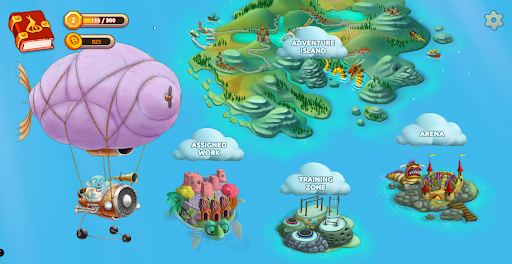
Teachers can manage their classes and students from the Class Management section. Students can be grouped, and the teacher can print out a login card for each student. Parents can be invited, and you can produce a parent letter to send home. The letter also provides login information for the student and some basic information about the program. All of your current students are listed, and you can add parent emails as necessary. You can also upload a class list via an Excel spreadsheet to make things easier. Students can also use an SSO via Clever or Google. Matific is also very serious about student privacy. They adhere to strict policies that are easily accessible to teachers, schools, or districts. Privacy has become an area of more and more concern to school authorities, and rightly so. No online program should underestimate the seriousness of privacy to school systems.
The math activities are all related to real-world situations. This is excellent! For example, a fraction activity asked the student to cover slices of bread using cheese. A fraction was given, and the student covered the bread depending on the required fraction. Once the activity is completed, the student is given a positive, reinforcing message rather than simply praising. Students are also made aware of the points they garner via a counter at the top of the screen. They can also choose to leave the area of mathematics they started with to go to another location or a different section of the game. Some students who used the program for several weeks felt that the activities were fun and engaging; however, they also noted that they were most focused when limited to the time they were expected to use the program. From my limited experience, 30 minutes of assigned work was more than enough. Students felt the same. I also noted – in Beta! – shortly, teachers will be able to play an activity with their class. Students can log in via an Activity Code, and once students are logged in, they can do the activity together.
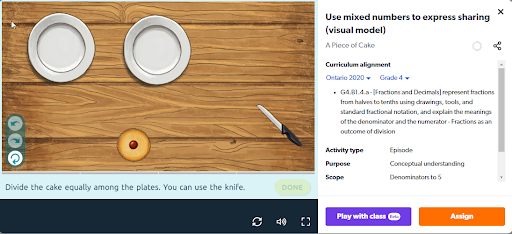
The most impressive feature of Matific is the teacher dashboard. The dashboard menu includes main menu items linked to Activities, Reports, and Class Management. The Activities menu leads to a sub-dashboard where the teacher can assign and manage learning activities. You can view a report and delete or re-assign the exercises for homework. A notable feature of this section is the ability for a teacher to personalize the assignment. Any time you can personalize according to a student’s need, the more likely students will overcome the difficulties they may have in each area of mathematics. Finding activities is delimited by strand. If you are looking to assign work in a particular strand, you have quick access to all activities of that strand via this menu item. You can also select the grade level and relevant curriculum. Ontario, Quebec, British Columbia and Nova Scotia’s mathematics curriculums are available in Canada. Once you choose the strand, activities are linked to curriculum expectations. The teacher can also see what area of development the activity impacts.
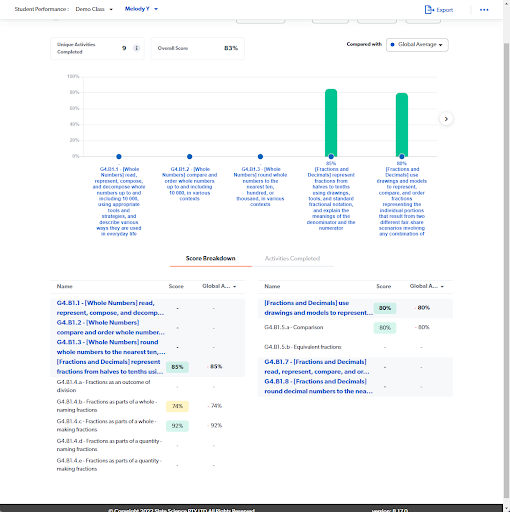
The Curriculum Guide section of Activities will excite most teachers. Here a teacher can plan their entire year by assigning all activities by strand to each week of the school year. Select the curriculum area you wish to focus on during a given week and then pre-assign the activity. You can preplan the entire year, and if you need to, you can also delay the activity. In this way, a teacher can do a Minds On activity, assign Action work, and then use Matific during the Consolidation phase or extra supporting work. Activities could be easily moved from one point of the year to another. I can’t emphasize enough the amount of time saved with this feature. It also encourages teachers to plan out their entire year according to their view of how math should be approached, though there are many examples of how math should be planned by curriculum area from one month to the next in a school year.
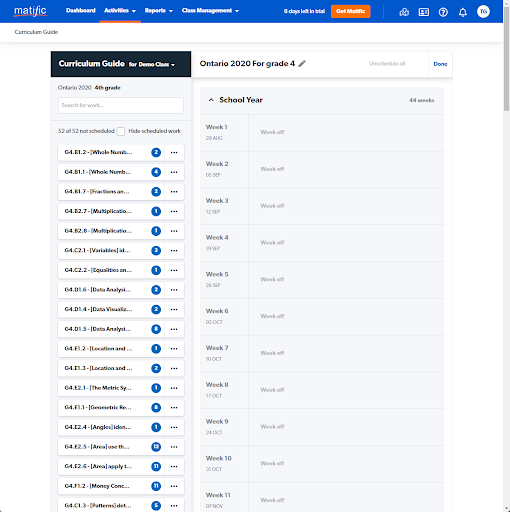
If assessment is learning, and learning is assessment, Matific has gone to great lengths to ensure that teachers know how students are performing and how they can augment their programs to ensure that students learn mathematics in a fun and meaningful way. Teachers can peruse all the assessment data collected for each student in the class. On the initial screen, teachers can quickly see students who have logged in, what percentage have completed assigned activities in detail, view class score performance and see the leaderboard for the class. The class score performance reflects the achievement for each strand of mathematics. Students’ names are hot-linked so that the teacher can drill down even further to gather more information. This is useful when providing feedback to both students and parents, but it also gives a teacher the needed data to meet each student’s needs according to their strengths or weaknesses.
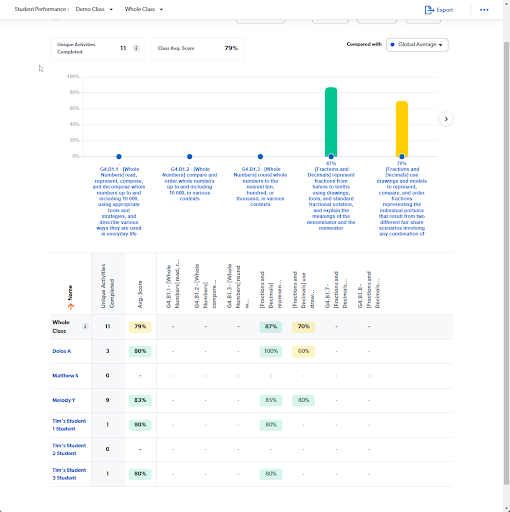
The Report section of the teacher’s dashboard is comprehensive and well planned for teachers to collect the data they will need to enhance and improve students’ understanding of mathematics, right down to curriculum expectations! This is exceptional! You can view the whole class, group, or individual student. If you have this data at your disposal, you can quickly inform a student and parent about their understanding in minute detail. You can then plan to meet particular needs and observe and document accommodations or modifications of your mathematics program to help support student learning. Currently, in beta is a placement test. I didn’t have the opportunity to review this portion of Matific, but it will be an added benefit if it’s as well designed as the other Matific reports. Knowing what students can do and understand is essential. You can plan a proper and compelling mathematics program only when you know what a student currently knows and comprehends.
To be transparent, I didn’t get a chance to examine closely every nuance of Matific. But to be honest, from what I observed, my conclusion probably wouldn’t change! Matific is a wonderfully rich and useful digital mathematics program. The students get an engaging experience that exposes them to a conceptual understanding of mathematics using a well-designed user interface that is easy to navigate and understand. Teachers will love the effective planning, assessment and reporting components of Matific. If you are looking for a digital mathematics platform to help you deliver a powerful math program to your students from K-6, look no further. Matific is that good, and it will only get better!









